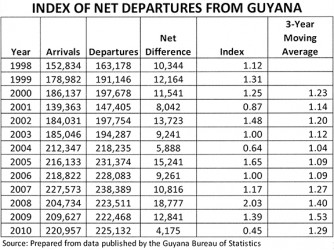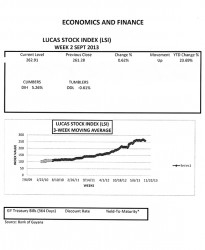Outward movement
Guyana continues to be a net exporter of its human resources and has one of the highest emigration rates in the world. Two of the five countries, Jordan and Syria, that Guyana is ahead of are in a highly unstable region with Syria being engulfed currently in a civil war. The other three countries, Nauru, Tonga and Micronesia, are small Pacific islands with unsustainable economies. Data sourced from outside of Guyana, including World Bank data, estimate that the net migration rate was about 10.100 last year. The outflow taking place from Guyana is reflected in the simple index created to show the outward movement of people from Guyana. Net departures are often used as a proxy for measuring migration levels and rates where such statistics are not specifically kept by a country. The metric therefore is at best an approximate measure of Guyanese turning their backs on the land of their birth, perhaps out of frustration and desperation.
No discernible policy
The index of net departures from Guyana rose noticeably in 2008 by 103 per cent from the base year of 2006. The base year was chosen to coincide with the base year used by the administration to measure economic performance in Guyana.
According to the index, constructed from data published by the Bureau of Statistics, the number of people leaving Guyana continues to grow significantly, about 53 per cent more from 2007 to 2009. Though somewhat tempered, the departures remained relatively high at 29 per cent more from 2008 to 2010 (the last period for which statistics are officially available to the public) as against any period prior to 2006. It is a trend that has been taking place for ever long, but one that seems to have gathered speed over time with no discernible policy to stimulate such an increase. From 2002 to 2005, the net departure from Guyana grew at an average of 11 per cent per year, but rose rapidly to 38 per cent from 2007 to 2010. It is not clear what is causing Guyanese to maintain such high migration rates, but this trend is typically associated with heightened insecurity and unfavourable views about economic opportunities.
Burgeoning crime
The administration seems quite happy to let Guyanese go since it seems to thrive in the social and economic chaos that it has created, and the insecurity that emanates from it. Further, the statistics about departures from Guyana that are yet to be published might hold many surprises, but the current conditions confronting the human resources of the country do not. Healthcare remains a problem. Crime is up six per cent as reported by the police. While that in itself is troubling, it is even more disturbing to realize that the police have no clue as to how to bring the burgeoning crime situation under control. Very few persons or institutions seem to have any confidence in the crime-fighting ability of the Guyana Police Force or in the belief that they have the capability to fight for justice in the courts. Fear, frustration and a lack of trust have stepped in and Guyanese have chosen to take matters into their own hands in some instances instead of relying on the Guyanese police. When the opportunity presents itself, they prefer to beat or even kill the perpetrator of a crime instead of waiting to turn the suspect over to the police. Justice could never be served in this way, but this is what law and order in Guyana has been reduced to.
Highly embarrassing

Active employees
The normal tendency is to assume that Guyanese are grabbing better opportunities abroad where they can and are opting out of the increasingly insecure environment in which they find themselves. Economic growth is occurring in Guyana. The latest data on the economy, as measured by gross domestic product (GDP), is that the economy grew by 3.9 per cent in the first half of 2013. But growth is not development. Though positive, growth is neither security nor a better quality of life. It simply means that more money has been accumulated in the economy. Set aside the fact that the return is meagre for the level of investment, an average of 32 per cent per annum, the problem is the distribution of the extra money. Using government data and eliminating debt service charges, subsidies and taxpayer refunds, compensation accounts for over 40 per cent of the cost of doing business in the public sector in Guyana. Increases in compensation are not automatic with an increase in economic performance. As could be gleaned from the statements of the Minister of Finance in his budget presentations of 2009 to 2013, about 59,000 or 24 per cent of active employees earned less than eight per cent of the total income generated by the economy last year, and less than half would have enjoyed 12 per cent of the income.
Speed and direction of changes

If sugar, other crops production, the condition of public procurement and the handling of the Skeldon, the Marriott, the airport expansion and the Amaila Falls projects were anything to go by, mismanagement of the economy plays a major part in the unsatisfactory level of economic growth and in the uneven distribution of wealth in the country. Together, they constitute the ingredients for the disaffection felt by many Guyanese. But as is typical, the administration often bolsters its claims of progress with the trends in credit by the commercial banks to consumers and businesses, even though Bank of Guyana data reveal that households receive only 14 per cent of such loans. It also points to the accumulation of foreign assets in the banking system as additional evidence of the health of the Guyana economy. When suitable, the administration points to the distribution of house lots as additional evidence of improvements in the economy of Guyana. In other words, any combination of favourable looking or sounding events will emerge as part of its narrative of how well off Guyanese ought to be.
Investigations
Yet, it is the human resources of Guyana who suffer as they do under human trafficking and rampant domestic abuse. In these cases, the intensity and speed of investigations seem to depend on the status of the perpetrators of the crime. The scales of justice never seem to weigh similar crimes evenly. In addition, data in the 2012 Annual Report of the Bank of Guyana indicate that over 40 per cent of the working age population, whether by choice or other circumstances, does not participate in the labour force. An estimated eight per cent of the working-age population is either in school or in an institution. The rest is unattended to and it does not appear as if any effort is being made to find out if any of those need help or encouragement to join the labour force, leaving one to believe that the quality of human resources of this country are of little value and interest to the powers that be.






